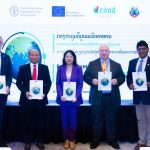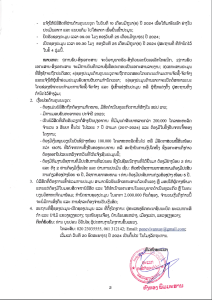ກອງປະຊຸມຂໍ້ມູນລະບົບອາຫານໃນ ສປປ ລາວ/Lao People’s Democratic Republic Food Systems Meeting
ວຽງຈັນ, ວັນທີ 26 ຕຸລາ 2022, 14.00
ຜົນໄດ້ຮັບຂອງການປະເມີນທີ່ສໍາຄັນຂອງລະບົບອາຫານໃນ ສປປ ລາວ ໄດ້ຮັບການເຜີຍແຜ່ແລ້ວ. ໄດ້ສະແດງໃຫ້ເຫັນວ່າ: ສາທາລະ ນະລັດ ປະຊາທິປະໄຕ ປະຊາຊົນລາວ ໄດ້ມີຄວາມຄືບໜ້າຢ່າງໃຫຍ່ຫຼວງໃນການບັນລຸຄວາມໝັ້ນຄົງທາງດ້ານສະບຽງອາຫານ ແລະ ຫຼຸດຜ່ອນຄວາມທຸກຍາກໃນຊົນນະບົດ ແລະ ມີຄວາມສາມາດບົ່ມຊ້ອນອັນແຂງແຮງ ເພື່ອກ້າວໄປສູ່ລະບົບສະບຽງອາຫານແບບຍືນຍົງ. ການຂາດແຄນ ແລະ ນໍ້າໜັກຕໍ່າໃນເດັກນ້ອຍຕໍ່າກວ່າ 5 ປີ ໄດ້ຫຼຸດລົງໃນຊຸມປີທີ່ຜ່ານມາ; ການຜະລິດເຂົ້າແມ່ນພຽງພໍໃນລະດັບຊາດ; ຜະລິດຕະພັນອາຫານຄຸນນະພາບສູງໄດ້ຮັບການຍອມຮັບ ແລະ ຊື່ນຊົມຈາກຜູ້ບໍລິໂພກພາຍໃນ ແລະ ທົ່ວໂລກ ເຊັ່ນ: ເຂົ້າໄກ່ນ້ອຍ, ກາ ເຟບໍລະເວນ ແລະ ຊາຜົ້ງສາລີ; ການຜະລິດສະບຽງອາຫານແມ່ນຍັງອີງໃສ່ລະບົບການປູກເຂົ້າແບບລ້ຽງຊີບຂະໜາດນ້ອຍ; ຊັບພະຍາ ກອນທຳມະຊາດທີ່ອຸດົມສົມບູນ (ປ່າໄມ້, ນ້ຳ, ຊີວະນາໆພັນ, ແຮ່ທາດ ແລະ ພູມສັນຖານທຳມະຊາດ) ພາຍໃຕ້ທ່າແຮງສີຂຽວ ແລະ ສະ ອາດຂອງປະເທດ; ການເປີດກວ້າງການຕະຫຼາດໄດ້ເຮັດໃຫ້ການສົ່ງອອກໄປຍັງປະເທດບ້ານໃກ້ເຮືອນຄຽງ ຄື: ຈີນ, ໄທ, ຫວຽດນາມ ໄດ້ເພີ່ມທະວີການຂະຫຍາຍຕົວຂອງປະເທດຊາດ. ເສັ້ນທາງລົດໄຟລາວ-ຈີນ ທີ່ໄດ້ພັດທະນາເມື່ອບໍ່ດົນມານີ້ ຈະຊ່ວຍເພີ່ມການເຊື່ອມໂຍງເຂົ້າກັບຕະຫຼາດຈີນ, ສະເໜີໃຫ້ປະຊາກອນໜຸ່ມທີ່ສຸດໃນອາຊີຕາເວັນອອກສຽງໃຕ້ ເຊັ່ນ: ສປປ ລາວ ມີອະນາຄົດອັນສົດໃສດ້ານຂະແໜງກະສິກຳ ແລະ ການພັດທະນາຊົນນະບົດ ແລະ ມີກຳລັງແຮງງານຈຳນວນຫຼວງຫຼາຍ.
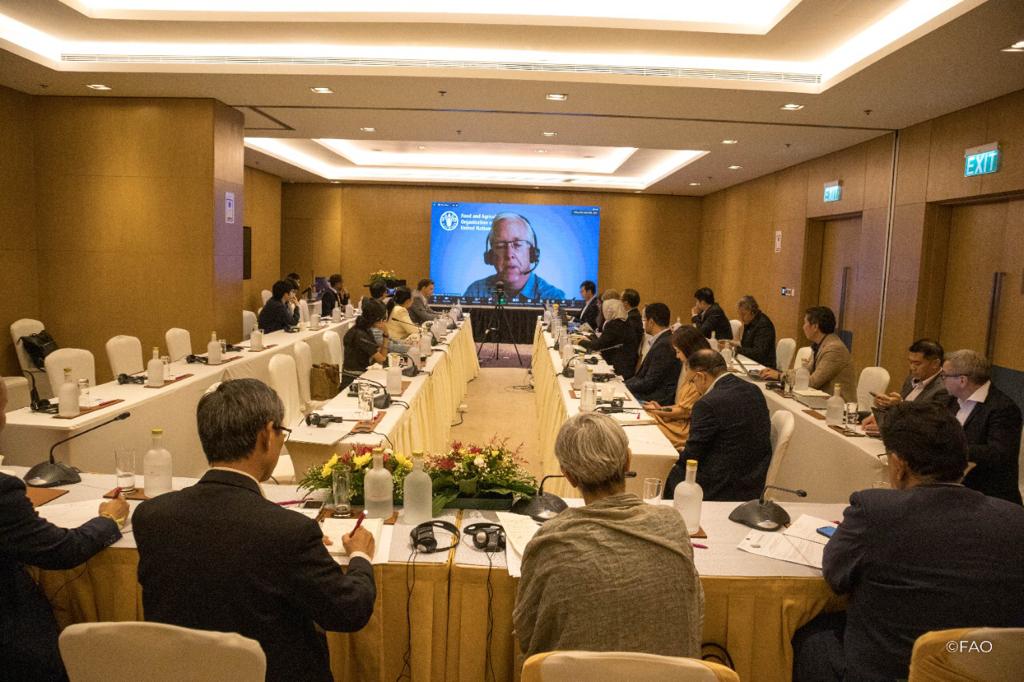
ການປະເມີນນີ້ແມ່ນສ່ວນຫນຶ່ງຂອງຂໍ້ລິເລີ່ມຮ່ວມກັນທີ່ເປີດຕົວໂດຍສະຫະພາບເອີຣົບ (EU), ອົງການອາຫານ ແລະ ການກະເສດແຫ່ງສະຫະປະຊາຊາດ (FAO) ແລະ ສູນວິໄຈດ້ານການພັດທະນາດ້ານກະສິກໍາຂອງປະເທດຝຣັ່ງ CIRAD, ໂດຍການຮ່ວມມືກັບລັດຖະບານປະເທດຕ່າງໆ. ໂດຍມີຈຸດປະສົງແມ່ນເພື່ອກໍານົດຂໍ້ຈໍາກັດທີ່ສໍາຄັນ ແລະ ຈຸດເລີ່ມຕົົ້ນສໍາລັບນະໂຍບາຍນະວັດກໍາ ແລະ ການແກ້ໄຂການລົງທຶນ ເພື່ອເຮັດໃຫ້ລະບົບອາຫານມີຄວາມຍືນຍົງ ແລະ ປົກຄຸມຫຼາຍຂຶ້ນ.
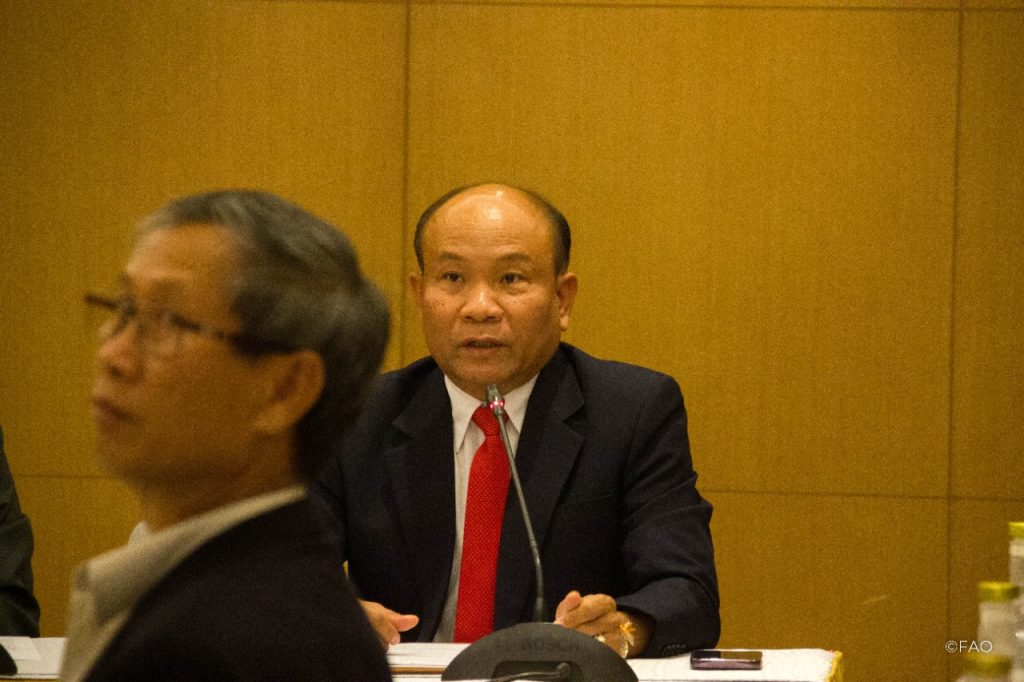
ໃນກອງປະຊຸມ ຂໍ້ມູນລະບົບອາຫານ ໃນ ສປປ ລາວ, ທ່ານ ສີປະໄພ ໄຊສົງຄາມ ຫົວໜ້າຫ້ອງການກະຊວງກະສິກຳ ແລະ ປ່າໄມ້ ໄດ້ຊົມເຊີຍຕໍ່ຄວາມມານະພະຍາຍາມຂອງ 3 ຝ່າຍ ຄື: EU, FAO ແລະ CIRAD ທີ່ໄດ້ສົມທົບກັນໜູນຊ່ວຍແກ້ໄຂຄວາມອຶດຫີວຢູ່ ສປປ ລາວ ໃຫ້ບັນລຸໄດ້ຢ່າງຕັ້ງໜ້າ. ທ່ານຍັງກ່າວຕື່ມອີກວ່າ: “ພວກເຮົາຮັບຮູ້ໄດ້ເຖິງວຽກງານອັນໜັກໜ່ວງທີ່ພວກເຮົາມີຢູ່ຕໍ່ໜ້າ, ເຊັ່ນ: ການປົກປັກຮັກສາສິ່ງແວດລ້ອມ, ພ້ອມດຽວກັນນັ້ນ ຍັງຕ້ອງປັບປຸງຊີວິດການເປັນຢູ່ ແລະ ສຸຂະພາບຂອງຜູ້ທີ່ມີຄວາມສ່ຽງທີ່ສຸດ, ໂດຍສະເພາະໃນເຂດຊົນນະບົດ. ດ້ວຍເຫດຜົນນີ້, ພວກເຮົາຮູ້ສຶກຂອບໃຈທີ່ໄດ້ຮ່ວມມືກັບບັນດາພາກສ່ວນກ່ຽວຂ້ອງເພື່ອກ້າວໄປຂ້າງໜ້າ ແນວຄວາມຄິດ ແລະ ຄຳແນະນຳທີ່ໄດ້ວາງອອກໃນບົດລາຍງານສະບັບນີ້ ແລະ ໃຫ້ຂໍ້ສັງເກດເຖິງຄວາມສຳຄັນຂອງວຽກງານນີ້ໃນຂັ້ນຕອນການສ້າງນະໂຍບາຍ.” ທ່ານກ່າວຕໍ່ໄປວ່າ “ພວກເຮົາຫວັງວ່າຈະສ້າງກາລະໂອກາດເຫຼົ່ານີ້ ແລະ ພ້ອມກັບການຫັນປ່ຽນລະບົບສະບຽງອາຫານ ແລະ ຄຸນນະພາບຊີວິດຂອງທຸກຄົນໃນປະເທດນີ້”.
ລະບົບສະບຽງອາຫານທີ່ພວມດຳເນີນຢູ່ໃນປັດຈຸບັນ ແມ່ນບໍ່ສາມາດປະຕິບັດໄດ້ຕາມຈຸດປະສົງຂອງການສະໜອງອາຫານທີ່ມີທາດບຳລຸງ ແລະ ສຸຂະພາບດີໃຫ້ແກ່ທຸກຄົນ ແລະ ປະກອບສ່ວນເຂົ້າໃນການເສີມຂະຫຍາຍໂອກາດ ການດຳລົງຊີວິດທີ່ຍືນຍົງທາງດ້ານສິ່ງແວດລ້ອມ. ພວກເຂົາເຈົ້າກໍາລັງຖືກທ້າທາຍໂດຍປັດໃຈຈໍານວນຫນຶ່ງ, ລວມທັງການປ່ຽນແປງອາຫານ, ເຕັກໂນໂລຢີ, ຕົວເມືອງແລະ ການປ່ຽນແປງດິນຟ້າອາກາດ. ອາດຈະມີອາຫານພຽງພໍເພື່ອລ້ຽງທຸກຄົນ – ການປ້ອງກັນພາລະດ້ານສຸຂະພາບສອງດ້ານຂອງການຂາດສານອາຫານ ແລະ ພະຍາດອ້ວນ – ແນວໃດກໍ່ຕາມ, ຄວາມບໍ່ສົມດຸນທາງເສດຖະກິດ ແລະ ອານາເຂດ ແມ່ນຍ້ອນວ່າລະບົບອາ ຫານບໍ່ໄດ້ສ້າງຜົນຕອບແທນ ທາງດ້ານເສດຖະກິດທີ່ຍຸດຕິທໍາສໍາລັບທຸກຄົນ, ໂດຍສະເພາະຜູ້ຜະລິດຂະໜາດນ້ອຍ, ເຮັດໃຫ້ເກີດວົງຈອນອັນບໍ່ມີທີ່ສິ້ນສຸດຂອງຄວາມບໍ່ແນ່ນອນ ແລະ ຄວາມທຸກຍາກ. ພວກເຂົາເຈົ້າຕ້ອງການການຫັນປ່ຽນ ຖ້າຫາກວ່າພວກເຮົາຈະບັນລຸເປົ້າໝາຍການພັດທະນາແບບຍືນຍົງ.
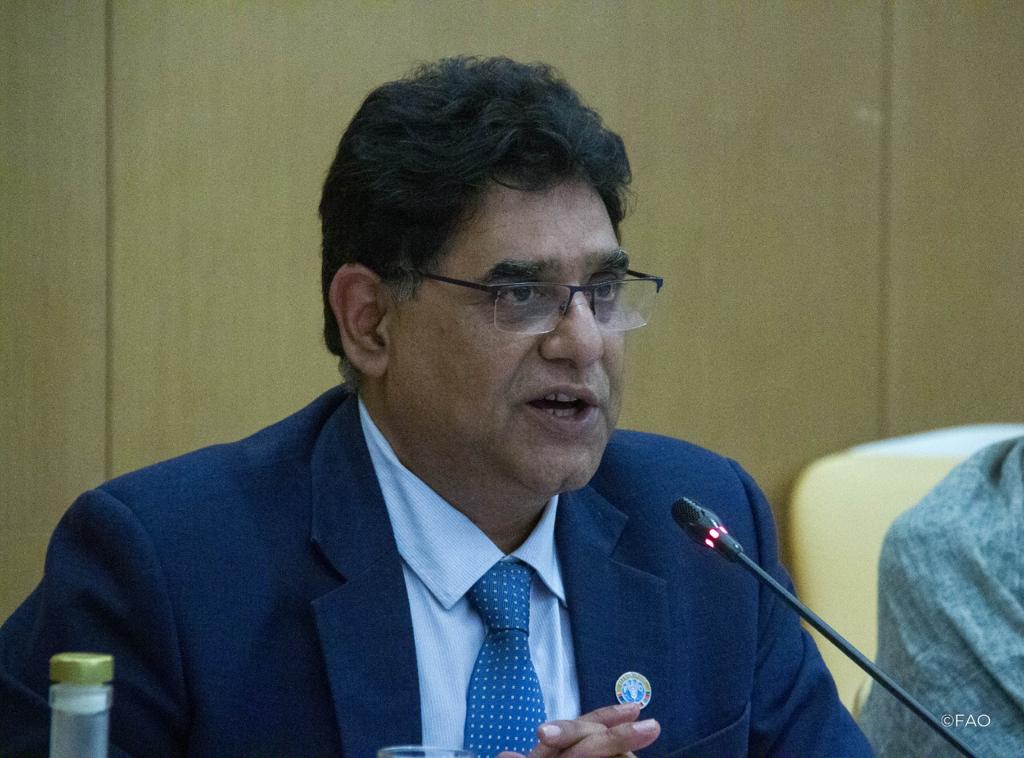
ທ່ານ ນາຊາ ຮາຢັດ ຜູ້ຕາງໜ້າອົງການອາຫານ ແລະ ການກະເສດ ປະຈຳ ສປປ ລາວ, ໃຫ້ຂໍ້ສັງເກດວ່າ: “ສປປ ລາວ ບໍ່ມີຄວາມສົງໃສວ່າມີຄວາມຄືບໜ້າອັນໃຫຍ່ຫຼວງໃນຊຸມປີຜ່ານມານີ້ ໃນການບັນລຸຄວາມໝັ້ນຄົງດ້ານສະບຽງອາຫານ. ແນວໃດກໍ່ຕາມ, ບົດລາຍງານທີ່ເປີດຕົວໃນມື້ນີ້ຮຽກຮ້ອງໃຫ້ມີທັດສະນະຂອງລະບົບ ສໍາລັບ ສປປ ລາວ ເພື່ອແກ້ໄຂບັນຫາສິ່ງທ້າທາຍທີ່ໄດ້ກໍານົດ ແລະ ວິທີການແກ້ໄຂທີ່ມີທ່າແຮງ” ທ່ານກ່າວຕື່ມວ່າ: “ພຽງແຕ່ເມື່ອສິ່ງທ້າທາຍຕົ້ນຕໍຂອງລະບົບສະບຽງອາຫານໃນ ສປປ ລາວ ໄດ້ຮັບການຍອມຮັບ, ການແກ້ໄຂທີ່ເປັນໄປໄດ້ເພື່ອເຮັດໃຫ້ພວກມັນມີຄວາມຍືນຍົງ ແລະ ທັງໝົດສາມາດຖືກຮັບຮູ້ດ້ວຍການຫັນປ່ຽນຕົວຈິງຂອງລະບົບອາຫານຂອງປະເທດ “.
ໂດຍນຳໃຊ້ວິທີການແບບລວມສູນ, ການປະເມີນໄດ້ລວບລວມຜູ້ມີບົດບາດໃນລະບົບສະບຽງອາຫານຂອງ ສປປ ລາວ ໂດຍຜ່ານຂະບວນການປຶກສາຫາລື ເຊິ່ງເຂົາເຈົ້າໄດ້ແລກປ່ຽນຄວາມຄິດເຫັນກ່ຽວກັບບັນຫາ ແລະ ສິ່ງທ້າທາຍທີ່ສຳຄັນ ແລະ ວິເຄາະວິທີແກ້ໄຂທີ່ອາດເປັນໄປໄດ້. ຜົນໄດ້ຮັບຂອງຂະບວນການປຶກສາຫາລືນີ້ ໄດ້ຖືກນໍາສະເໜີຢູ່ໃນໂປຣໄຟລ໌ປະເທດທີ່ຫາກໍ່ຈັດພີມມາ. ມັນຈະເປັນພື້ນຖານ ເພື່ອໃຫ້ຄວາມສໍາຄັນການແຊກແຊງໃນຂົງເຂດສໍາຄັນຂອງລະບົບສະບຽງອາຫານ. ເພື່ອຍົກສູງຄວາມຍືນຍົງຂອງລະບົບອາ ຫານຂອງປະເທດ, ຄວນໄດ້ຮັບການພິຈາລະນາໃນເວລາສ້າງນະໂຍບາຍດັ່ງນີ້:
○ ປັບປຸງຄຸນນະພາບອາຫານແຫ່ງຊາດ ໂດຍການສະໜັບສະໜູນລະບົບກະສິກຳທີ່ຫຼາກຫຼາຍ, ໃນຂະນະທີ່ຈຳກັດການແຜ່ກະຈາຍຂອງອາຫານປຸງແຕ່ງທີ່ບໍ່ປອດໄພ;
○ ຊຸກຍູ້ໃຫ້ມີການປະຕິບັດທີ່ດີ ແລະ ເພີ່ມທະວີການກວດກາ ແລະ ຄວບຄຸມການປຸງແຕ່ງ ແລະ ຕາມລະບົບຕ່ອງໂສ້ການສະໜອງ, ໃນຂະນະທີ່ປັບປຸງການຮັບຮູ້ຂອງປະຊາຊົນ ເພື່ອຫຼຸດຜ່ອນການບໍລິໂພກອາຫານທີ່ບໍ່ປອດໄພ;
○ ສະໜັບສະໜູນນະວັດຕະກໍາ ແລະ ທັກສະໃນການສ້າງລະບົບກະສິກຳສະອາດ ແລະ ຕ່ອງໂສ້ອາຫານແບບຍືນຍົງ, ພ້ອມດຽວກັນນັ້ນ ຢຸດຕິການສົ່ງເສີມການປູກພືດເປັນເງິນສົດທີ່ບໍ່ຍືນຍົງ (ການປູກພືດຊະນິດດຽວ); ແລະ
○ ປັບປຸງຄວາມສາມາດຂອງຊາວກະສິກອນ ທີ່ມີຄວາມສ່ຽງໃຫ້ສາມາດປັບໂຕເຂົ້າກັບການປ່ຽນແປງຂອງດິນຟ້າອາກາດ ແລະ ຜົນກະທົບທາງດ້ານເສດຖະກິດ ຜ່ານລະບົບກະສິກຳທີ່ຫຼາກຫຼາຍ ແລະ ຕະຫຼາດ.
Lao People’s Democratic Republic Food Systems Meeting
Vientiane, 26 October 2022, 14.00
Results of a major assessment of the food system in Lao PDR have been released. They show that:
The Lao People’s Democratic Republic has made significant progress towards achieving food security and reducing rural poverty, and has strong potential to move towards sustainable food systems. Stunting and underweight in children below five years of age have decreased in recent years; self-sufficiency has been achieved in rice production at the national level; very high-quality food products are recognized and appreciated by domestic and global consumers, such as Khao kai noi rice, Boloven coffee, and Phongsaly tea; food production is still largely based on small-scale subsistence rice farming systems; rich natural resources (forests, waterways, biodiversity, minerals, and natural landscapes) underpin the country’s green and clean potential; opening up to markets has led to increased exports to neighbouring countries, such as China, Thailand, and Viet Nam, contributing to national growth. The recently developed Laos-China railway will increase linkages with the Chinese market, offering one of the youngest populations in South-East Asia like Lao PDR with a promising future for the agricultural sector and rural development, and a large labour force.
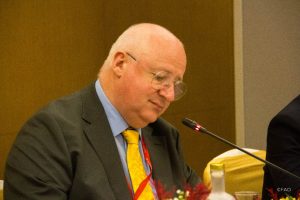
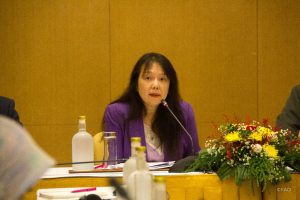
The assessment was part of a joint initiative launched by the European Union (EU), the Food and Agriculture Organization of the United Nations (FAO), and the French research centre for agricultural development, CIRAD, in cooperation with governments. Its purpose was to identify key constraints and entry points for innovative policy and investment solutions to make food systems more sustainable and inclusive.
During the announcement workshop, MrMr. Sypaphay XAISONGKHAM, Permanent Secretary, Ministry of Agriculture and Forestry, congratulated the tripartite efforts, namely the EU, FAO and CIRAD, to join forces to help end hunger in Lao PDR, while reaching its potential. He added “We recognize the daunting tasks we have in front of us, such as protecting the environment while also needing to improve the livelihoods and health of the most vulnerable, particularly in rural areas. For this reason, we are grateful to be working with all stakeholders to move forward on the ideas and recommendations put forward in this report and note the importance of this work done at the policy formulation stage.” “We look forward to building on these opportunities and simultaneously and sustainably transforming food systems and the quality of life for all in this country”, he continued.
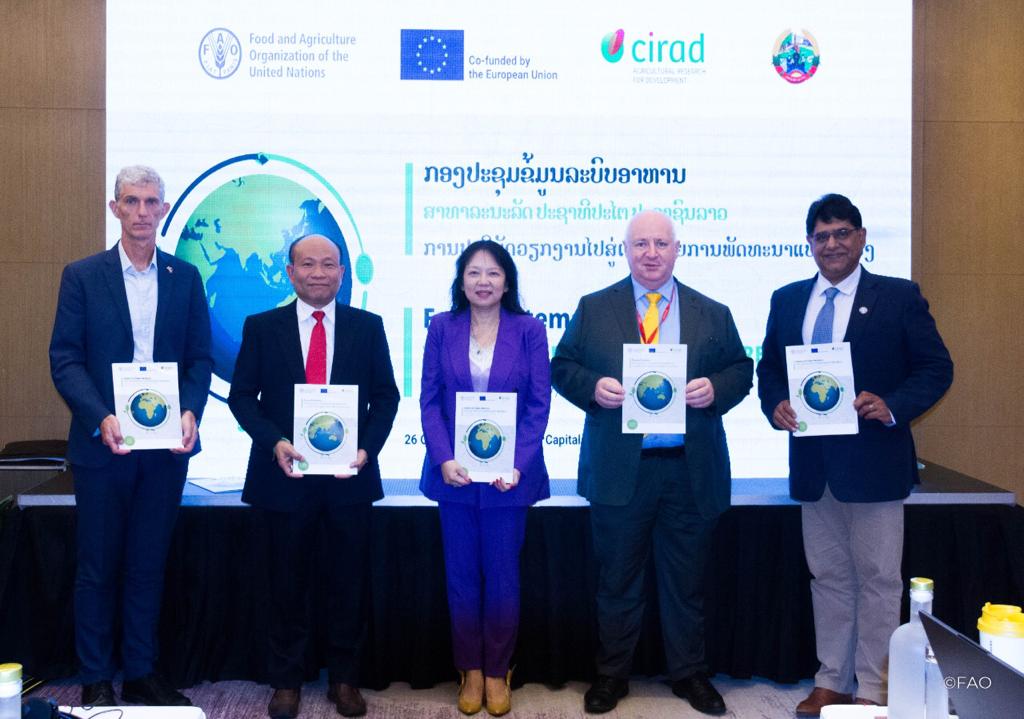
Food systems as currently operating are unable to fulfill their purpose of providing nutritious and healthy food for all and contributing to enhanced livelihood opportunities in an environmentally sustainable way. They are being challenged by several factors, including changing diets, technology, urbanization and climate change. There may be enough food to potentially feed everyone – preventing the dual health burdens of malnutrition and obesity-, however, the economic and territorial imbalances are such that food systems do not generate fair economic returns for all actors, particularly for small-scale producers, triggering an endless cycle of precariousness and poverty. They need transforming if we are to achieve the Sustainable Development Goals.
Mr. Nasar Hayat, FAO Representative to Lao PDR, noted that “Lao PDR has no doubt made significant progress in recent years towards achieving food security. Yet, the report launched today demands for a system perspective for Lao PDR to address the challenges identified and come up with viable and holistic solutions”. “Only when the main challenges of food systems in Lao PDR are acknowledged, possible solutions to make them more sustainable and inclusive could be realized with a real transformation of the country’s food systems”, he added.
Using a holistic approach, the assessment gathered a wide range of food system actors in Lao PDR through a consultation process during which they shared views on key issues and challenges and analyzed potential solutions. The results of this consultation process is presented in the country profile just published. It will serve as a basis to prioritize interventions in key areas of the food system. To enhance the sustainability of the country’s food systems, the following should be considered when formulating policies:
- improve the national diet quality by supporting diversified farming systems, while limiting the spread of unsafe processed foods;
- encourage good practices and strengthen inspections and controls in processing and along the supply chain, while improving public awareness to reduce consumption of unsafe food;
- support innovations and skills to build clean agricultural systems and sustainable food chains, while ending the promotion of unsustainable cash crops (monocultures); and
- improve the capability of vulnerable farmers to be more resilient to climate events and economic shocks through diversified farming systems and market outlets.
